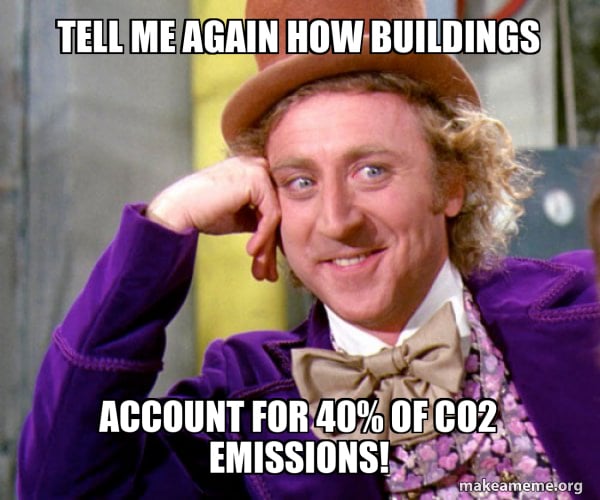“Buildings account for 40% of all energy consumption and represent 40% of all greenhouse gas emissions”. Yes, this is another article that starts with the same statistic you've heard for the past decade! Like a bad smell, it permeates every research report, media article and industry conference you've attended in recent memory. It must be the most commonly used statistic to demonstrate the impact of buildings on the environment, but how many people actually know where the figure comes from and how it was calculated?
“There are three ways to not tell the truth: lies, damned lies, and statistics,” is a saying that was made famous by Mark Twain, though he attributed it to 19th-century British Prime Minister Benjamin Disraeli. It points to a problem with statistics, which is that while they can be true, they can change meaning depending on the context in which they are placed, and then there are multiple different ways of interpreting the same results, creating the opportunity for misinterpretation and misuse.
This 40% statistic has become so ubiquitous in the buildings sector that it rarely even warrants a link or a citation. It is a strong reminder of the impact of buildings on energy consumption but is it even valid? Encouragingly, if you dig deep enough, you arrive at a reassuring answer - the statistic is based on quite comprehensive data from prominent research organizations.
According to the US Energy Information Administration (EIA), buildings in the United States account for around 40% of total energy consumption and 39% of carbon dioxide emissions. The EIA gathers data on US building energy consumption through its Commercial Buildings Energy Consumption Survey (CBECS) and its Residential Energy Consumption Survey (RECS). Data is collected through a combination of building audits, surveys, and utility data.
According to the European Commission, buildings in the EU account for around 40% of total energy consumption and 36% of greenhouse gas emissions. Data has been gathered through the EU’s Energy Performance of Buildings Directive (EPBD) since 2002, which requires member states to establish national databases of building energy performance. The data comes from energy performance certificates that are required for all buildings at the time of sale or rental.
Other organizations, such as the United Nations Environment Programme (UNEP) reports that buildings are responsible for around 39% of global energy-related CO2 emissions. Research by the Global Alliance for Buildings and Construction (GlobalABC) suggests that buildings account for around 39% of total energy consumption and 36% of global carbon dioxide emissions. While the International Energy Agency (IEA) estimates that buildings account for around 32% of total global energy consumption and 19% of total greenhouse gas emissions.

While some variation exists between these official statistics from different regions, they are within close enough range to be rounded-up to a more general and compelling 40% of energy consumption and 40% of CO2 emissions. Built on this very official foundation, the “40% building stats” have spread across the world and circulated for over two decades —demonstrated by its use in this 2002 Directive by the European parliament.
These are not recirculated old statistics, however, it’s just that as building efficiency increases against population growth and general development, the proportional impact of buildings on the environment has largely stayed the same since the early 2000s —as shown on pages 36-40 of the EIA’s Monthly Energy Review from January 2023. This continuity further serves the popularity of the statistic, and it is used widely to demonstrate the massive impact that buildings have on our environment and the acceleration of climate change.
The reality is that the impact of buildings on the environment is huge, the data is reliable and accurate, but that doesn’t mean it tells the whole story, and to provide that context we can use other statistics. Are the 40% building stats so shocking when you consider that humans, on average, spend 90% of our time indoors, for example, or when you ponder all the spaces that might be considered a building?
This is not meant to take away from the message that these statistics represent, but to encourage using other statistics that may better tell the story of buildings and the environment.
As much as 30% of all electricity consumed in US buildings is wasted, according to Energy Star, a government program using data from the US Environmental Protection Agency (EPA). This statistic provides a different side to the story, not one of population growth and development, but a much more damning report of wastefulness and inefficiency.
As much as 75% of EU building stock is considered “energy inefficient”, according to European Commission data. This statistic also highlights the inefficiency problem but as new building codes and environmental regulations take hold across Europe, this statistic will better show our progress than using total consumption and emissions figures, which are influenced by everything else.
While all statistics have their limitations, biases, and contexts, they remain a powerful tool for communication in the modern world. However, statistics can often lose their power when overused, just becoming part of the rhetoric without provoking any thought or emotion in its audience. So, next time you see “that 40% statistic” about the impact of buildings on the environment appreciate the depth of research that has gone into it and the meaning of the message, but don’t forget to look at the rest of the story too.



